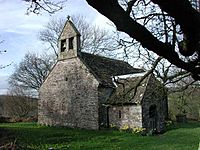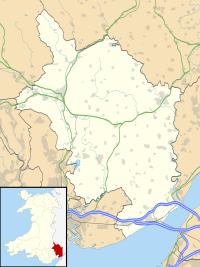Church of the Holy Cross, Kilgwrrwg facts for kids
Quick facts for kids Church of the Holy Cross, Kilgwrrwg |
|
|---|---|
| Church of the Holy Cross | |

"a medieval church from a now deserted village"
|
|
| 51°40′56″N 2°46′45″W / 51.6822°N 2.7793°W | |
| Location | Kilgwrrwg, Monmouthshire |
| Country | Wales |
| Denomination | Church in Wales |
| Website | Holy Cross, Kilgwrrwg |
| History | |
| Status | Parish church |
| Founded | C13th century |
| Architecture | |
| Functional status | Active |
| Heritage designation | Grade II* |
| Designated | 19 August 1955 |
| Architectural type | Church |
| Style | Early English/Decorated |
| Administration | |
| Parish | Kilgwrrwg |
| Deanery | Netherwent |
| Archdeaconry | Monmouth |
| Diocese | Monmouth |
The Church of the Holy Cross is an old church located in Kilgwrrwg, Monmouthshire, Wales. It is a parish church, which means it serves the local community. This church once belonged to a village that is now empty.
It is a very important historical building, recognized as a Grade II* listed building. This means it has special historical or architectural value. The Church of the Holy Cross is still used today as an active church. It is part of the Severn Wye Ministry Area.
Contents
History of the Church
How the Church Began
The writer Clive Aslet once called this church "the remotest" in Wales. He shared a story about how the church was founded. The legend says it was built where two cows, called heifers, stopped to rest while pulling a yoke.
The churchyard around the church is round. This shape suggests that the site might have been used for religious purposes even before Christianity. It could have been a special place for the Celts. The church building we see today is from the early medieval period. Experts believe it was built in the 13th century.
Changes Over Time
The church has been changed and updated many times. Some parts of the church were added in the 16th, 17th, and 19th centuries. By the early 1800s, the church was in very poor condition. People even described it as looking like a "dilapidated sheepfold" (a broken-down pen for sheep).
A local school teacher named James Davies helped fix the church in 1820. He paid for most of the repairs himself. Later, in 1871, John Prichard did more major rebuilding work. The church was also restored again in the late 20th century. During these later repairs, the church was officially named Holy Cross. Before that, its original name was not known.
Church Design and Features
Building Materials and Style
The Church of the Holy Cross is built from a type of stone called Old Red Sandstone. Its design mixes two styles of Gothic architecture: Early English and Decorated. The church has a chancel (the area near the altar), a nave (the main part where people sit), a porch, and a bellcote (a small structure holding a bell).
The inside of the church is quite simple. The chancel has a plain wooden frame, called a truss, instead of a grand arch. The Grade II* listing for the church notes that it is an "attractive and little altered medieval church." It is special because it comes from a village that is now deserted.
Churchyard Cross and Bell
In the churchyard, there is an old cross. This cross is also a Grade II listed structure. It is also a Scheduled monument, which means it is a nationally important archaeological site. This cross is the only complete churchyard cross left in all of Monmouthshire.
The church has one bell. This bell was made by the William Evans Foundry, a company located in Chepstow.


